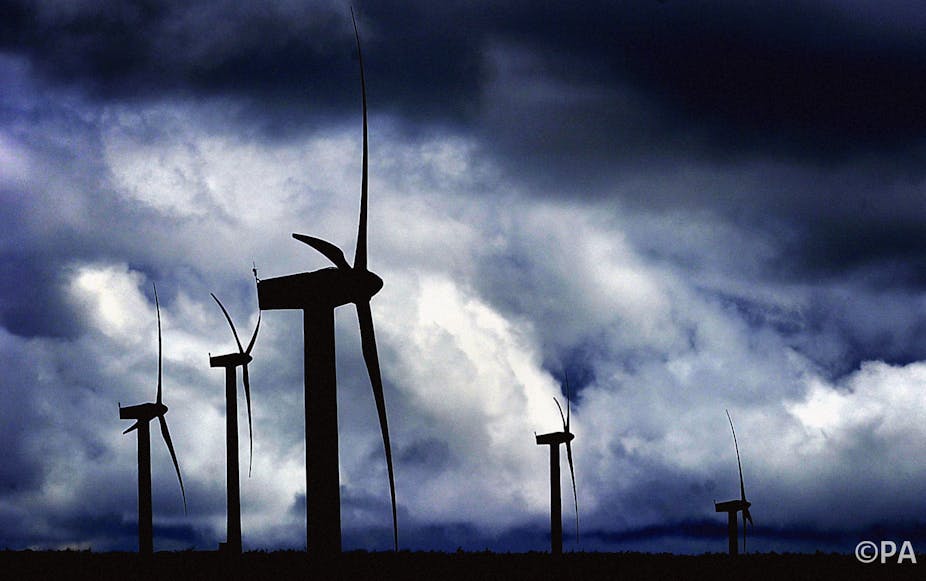Could Scotland benefit from having an independent electricity system? Our report published this week found that it could – if it meant Scotland paying for (and benefiting from) its own renewable energy, without having to pay for the expensive UK nuclear power programme recently agreed south of the border.
The Scottish government has committed itself to a target of meeting all its electricity demand from renewable energy by 2020. It has also refused to allow new nuclear power stations to be built in Scotland. The problem for a nuclear-free Scotland is two-fold.
First, Scotland faces the prospect of having to pay not only the high and increasing price for nuclear power – the “strike price” required to persuade French utility giant EDF to build Hinkley Point C nuclear power station – but also its share of UK’s renewable power subsidies. Second, it seems unlikely that the UK government will now fund much in the way of offshore renewables around Scotland.
On the other hand, Scotland has made strong progress in deploying renewable energy in the country, with onshore wind in particular adding to biomass combined heat and power, some solar and hydro-power capacity. We project that by 2018, the earliest plausible date that the market could be restructured to allow Scotland greater electricity independence, around two-thirds of the Scottish government’s renewable energy target will have been met. The issue would then be whether it would be cost-effective for Scotland to finance the other one-third of the target while not carrying the burden of paying for nuclear power.
The cost of nuclear power
We calculated what a renewable energy programme controlled and paid for by Scotland would cost, if its government paid incentives for renewables broadly similar to those the UK government offered for nuclear power. Under the UK’s Electricity Market Reform (EMR) programme to be phased in from next year, nuclear power receives very long, 35-year premium price contracts, while renewable projects have just 15-year contracts. Scotland could offer 20-year premium price contracts to developers, as is the case under the current Renewables Obligation that the EMR scheme will replace.
Renewable energy projects could also be offered loan guarantees, as is offered to those investing in nuclear power. Contracts would also be offered to independent developers, whereas – at the moment – premium price contracts under EMR are only available to major electricity companies. That would lead to more projects for the same price. If these techniques were employed, onshore wind could be financed for around £76/MWh compared to the £92.50/MWh offered for Hinkley Point C nuclear power plant from 2023, when it is due to come online.
Matching subsidies, pound for poond
On the basis of these prices we estimate that if the UK government arranged for three, twin-reactor nuclear power stations to be built, the increased prices to all consumers from the nuclear and renewable programmes combined would be around 10.4%. In contrast, the cost to Scottish consumers would be an extra 7.2% to meet Scotland’s renewable electricity target. However, these increased prices would be paid only for 20 years, while in the rest of the UK the price increases associated with funding nuclear power would last some 35 years. If the UK built just Hinkley C and Sizewell C the price increases for all low-carbon sources would be 8%, or 5.6% if only Hinkley C is built.
Although this calculation assumes that onshore wind is used to meet the bulk of the remaining elements of the target, the Scottish government would have discretion to fund some offshore renewables, for example tidal stream projects. However that would entail increasing prices for consumers beyond 7.2% or backing away from the 100% renewable target.
Greater changes are possible
There are other, more fundamental changes that an independent Scotland could make other than just independently managing its low-carbon incentives and regulations. In theory it could, for example, have different system operators run its electricity grid. Scotland could join the Scandinavian Nordpool system to utilise Swedish and Norwegian hydro reserves, as is done by Denmark. This would involve building an interconnector to carry power to and from Norway, which would take time.
Otherwise, to avoid having to spend a lot of money on gas power stations as back-up, Scotland would have to negotiate with the rest of the UK some shared method for assuring there is sufficient capacity to cope with the fluctuating nature of renewable energy. Using the same System Operator – National Grid – in both countries would be easiest, and this is politically straightforward, but restricts the degree to which Scotland would have a genuinely independent system.
The Scottish government itself, in its White Paper has preferred continuing with a shared System Operator. Yet the Scottish government foresees the UK will continue to fund Scottish renewables while excusing Scotland from paying for its nuclear power. In practice, the politics may demand that Scotland choose either to pay for its own new renewables, or share all the UK’s costs.

